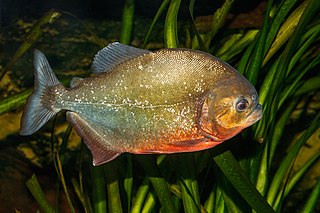
A piranha or piraña, a member of family Serrasalmidae, or a member of the subfamily Serrasalminae within the tetra family, Characidae in order Characiformes, is a freshwater fish that inhabits South American rivers, floodplains, lakes and reservoirs. Although often described as extremely predatory and mainly feeding on fish, their dietary habits vary extensively, and they will also take plant material, leading to their classification as omnivorous.
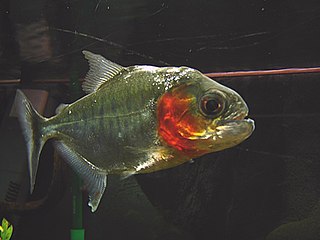
Serrasalmus is a genus of piranhas. They are collectively known as pirambebas; the "typical" piranhas like the piraya piranha are nowadays placed in Pygocentrus. Like all piranhas, Serrasalmus are native to South America.
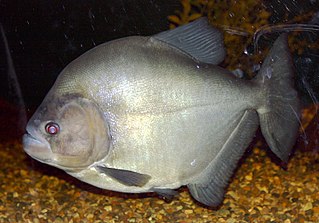
The redeye piranha, also known as the black piranha, white piranha, spotted piranha or yellow piranha, is a species of freshwater ray-finned fish, a piranha from the family Serrasalmidae. It is found in northern South America. It is the type species of the genus Serrasalmus.
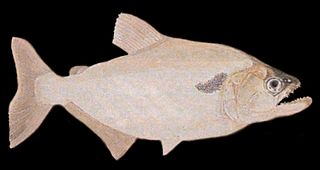
Serrasalmus elongatus is a slender and elongated shaped piranha from the S. humeralis group. It is commonly known as elongated piranha or pike piranha in reference to its shape. In its native range it is one of the smaller piranha species locally termed caribe pinche, like the iridescent piranha. This term gave rise to various trade names, like "Pingke piranha" and "Serrasalmus pinke" which is not a proper scientific name.

The sharp-snouted piranha is a species of serrasalmid endemic to Peru. It is part of the S. rhombeus complex. It reaches a maximum size of around 7 inches (18 cm). Individuals often exhibit a red throat, similar to that of Pygocentrus nattereri. It is also known as ruby-throated diamond piranha or "ruby-red piranha"; the latter name is also used for the speckled piranha.
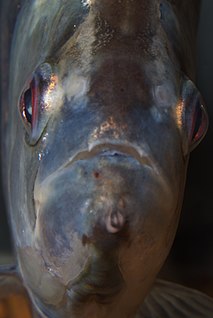
Serrasalmus geryi is a species of fish found in the lower Tocantins and Araguaia Rivers of Brazil. This rare Serrasalmus is the one piranha of the genus Serrasalmus that can coexist with others of the same species. Gery's Piranha reaches sizes up to 12 inches in length.

The Serrasalmidae (serrasalmids) are a family of characiform fishes, recently elevated to family status. It includes more than 90 species. The name means "serrated salmon family", which refers to the serrated keel running along the belly of these fish. Fish classified as Serrasalmidae are also known by these common names: pacu, piranha, and silver dollar. These common names generally designate differing dental characteristics and feeding habits.

Pristobrycon is a genus of piranhas from the Orinoco and Amazon Basins, as well as rivers in the Guianas.
Palometa is a name used for several species of fish:
Ruby-red piranha can refer to either of 2 species of these fish:
Spotted piranha can refer to either of 2 species of these fish:
Caribe dorado is a local term for either of 2 species of piranha:
Caribe pinche is a local term for either of 2 species of piranha:
Pristobrycon striolatus is a species of serrasalmid.
S. niger is an abbreviation of a species name. In binomial nomenclature, the name of a species is always the name of the genus to which the species belongs, followed by the species name. In S. niger, the genus name has been abbreviated to S. and the species has been spelled out in full. In a document that uses this abbreviation, it should always be clear from the context which genus name has been abbreviated.

In a speed typing contest contestants compete to attain the highest accurate typing speeds. These contests have been common in North America since the 1930s and were used to test the relative efficiency of typing with the Dvorak and QWERTY keyboard layouts.
Hevea spruceana is a species of rubber tree in the genus Hevea, belonging to the family Euphorbiaceae. It is native to the rainforests of northern Brazil and Guyana. It is named in honour of the English botanist Richard Spruce who spent the years 1849 to 1864 exploring the Amazon basin and sending botanical specimens back to Europe.
Kritskyia is a genus of monogeneans in the family Dactylogyridae.








